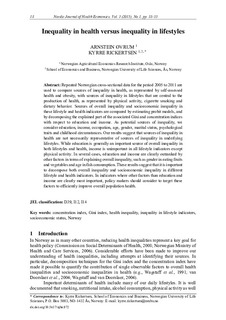| dc.contributor.author | Øvrum, Arnstein | |
| dc.contributor.author | Rickertsen, Kyrre | |
| dc.coverage.spatial | Norway | nb_NO |
| dc.date.accessioned | 2018-03-13T13:04:28Z | |
| dc.date.available | 2018-03-13T13:04:28Z | |
| dc.date.created | 2015-09-23T16:14:15Z | |
| dc.date.issued | 2015 | |
| dc.identifier.citation | Nordic Journal of Health Economics. 2015, 3 (1), 18-33. | nb_NO |
| dc.identifier.issn | 1892-9729 | |
| dc.identifier.uri | http://hdl.handle.net/11250/2490317 | |
| dc.description.abstract | Repeated Norwegian cross-sectional data for the period 2005 to 2011 are used to compare sources of inequality in health, as represented by self-assessed health and obesity, with sources of inequality in lifestyles that are central to the production of health, as represented by physical activity, cigarette smoking and dietary behavior. Sources of overall inequality and socioeconomic inequality in these lifestyle and health indicators are compared by estimating probit models, and by decomposing the explained part of the associated Gini and concentration indices with respect to education and income. As potential sources of inequality, we consider education, income, occupation, age, gender, marital status, psychological traits and childhood circumstances. Our results suggest that sources of inequality in health are not necessarily representative of sources of inequality in underlying lifestyles. While education is generally an important source of overall inequality in both lifestyles and health, income is unimportant in all lifestyle indicators except physical activity. In several cases, education and income are clearly outranked by other factors in terms of explaining overall inequality, such as gender in eating fruits and vegetables and age in fish consumption. These results suggest that it is important to decompose both overall inequality and socioeconomic inequality in different lifestyle and health indicators. In indicators where other factors than education and income are clearly most important, policy makers should consider to target these factors to efficiently improve overall population health. | nb_NO |
| dc.language.iso | eng | nb_NO |
| dc.rights | Navngivelse 4.0 Internasjonal | * |
| dc.rights.uri | http://creativecommons.org/licenses/by/4.0/deed.no | * |
| dc.subject | concentration index | nb_NO |
| dc.subject | Gini index | nb_NO |
| dc.subject | health inequality | nb_NO |
| dc.subject | inequality in lifestyle indicators | nb_NO |
| dc.subject | socioeconomic status | nb_NO |
| dc.title | Inequality in health versus inequality in lifestyles | nb_NO |
| dc.type | Journal article | nb_NO |
| dc.type | Peer reviewed | nb_NO |
| dc.description.version | publishedVersion | nb_NO |
| dc.rights.holder | © 2015 the author(s). This article is an open access article distributed under the terms and conditions of the Creative Commons Attribution license (http://creativecommons.org/licenses/by/4.0/). | nb_NO |
| dc.source.pagenumber | 18-33 | nb_NO |
| dc.source.volume | 3 | nb_NO |
| dc.source.journal | Nordic Journal of Health Economics | nb_NO |
| dc.source.issue | 1 | nb_NO |
| dc.identifier.doi | 10.5617/njhe.972 | |
| dc.identifier.cristin | 1267022 | |
| dc.relation.project | Norges forskningsråd: 233800 | nb_NO |
| dc.relation.project | Norges forskningsråd: 182289 | nb_NO |
| dc.relation.project | Norges forskningsråd: 184809 | nb_NO |
| cristin.ispublished | true | |
| cristin.fulltext | original | |
| cristin.qualitycode | 1 | |

